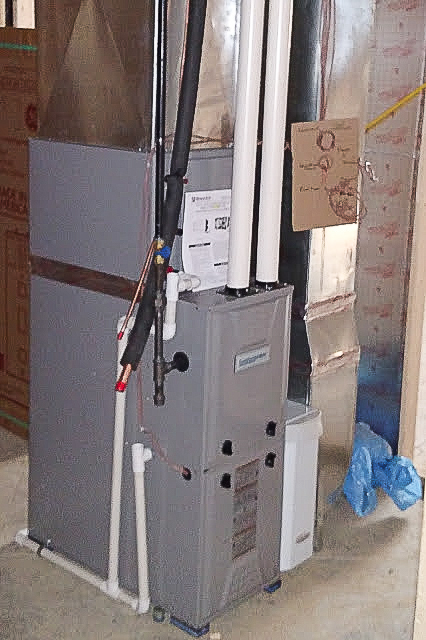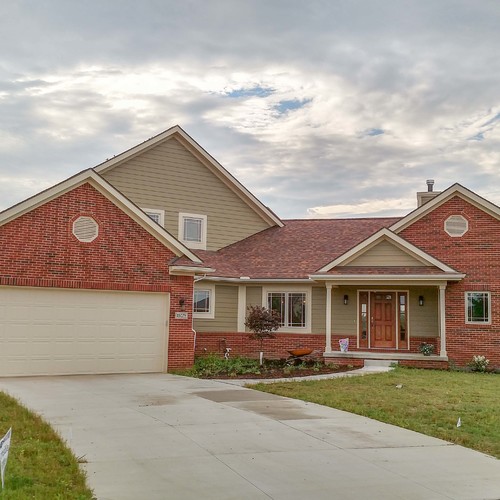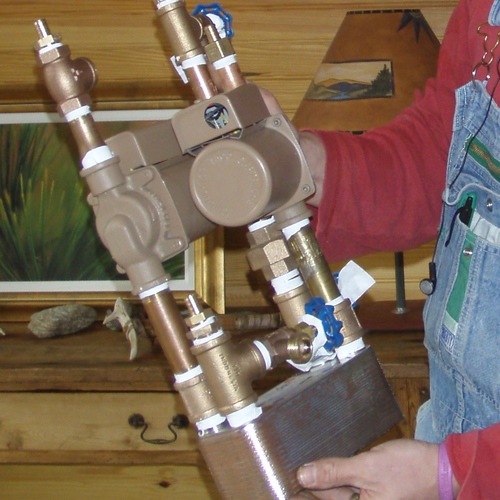Image Credit: Reid Baldwin
Image Credit: Reid Baldwin Most of the return ducts were created by closing off a stud bay. Although some articles advise against this practice, the reason seems mostly applicable to ducts located in unconditioned space. Supply ducts are oval metal, sometimes placed in exterior walls by necessity.
Editor’s note: This is one of a series of guest blogs by Reid Baldwin about the construction of his house in Linden, Michigan. You can read his entire blog here.
This post addresses two parts of the HVAC system, heating and air conditioning. Ventilation will be addressed in another post.
In Michigan, most people install a natural gas forced-air furnace and air conditioning. Those willing to spend money on a premium system consider radiant-floor heating. However, highly insulated houses have some differences from typical houses which can change what types of heating and cooling systems are appropriate.
Homes which take insulation and airtightness to extremes, such as those that meet the Passivhaus standard, usually end up with different types of heating and cooling systems, such as one or two ductless minisplit heat pumps. In terms of insulation, this house falls into a middle ground between typical houses and Passivhaus houses. So, it wasn’t obvious whether our systems should be like typical houses, like Passivhaus houses, or some other choice. (Well, maybe it would have been obvious to someone with less tendency than me to overthink these things.)
Highly insulated houses have a much lower heating demand than typical houses. Why wouldn’t they just use smaller versions of same types of systems that typical houses use? Mainstream HVAC equipment manufacturers don’t attempt to serve the highly insulated house market. The range of equipment sizes offered is based on typical house heating loads. In fact, most equipment installed in typical houses is considerably oversized.
Distributing heat is easier in a highly insulated house because the heat is not escaping as quickly. That opens up some possibilities. However, the warm floor feeling that many people like about radiant-floor heating would not be so noticeable in a highly insulated house.
People interested in net-zero-energy homes prefer all-electric systems, which can be supplied by PV panels. Ironically, spending more for highly efficient equipment is less likely to pay off in a low-load home. People who have spent extra money for insulation may want to recoup some of that by spending less on heating and cooling equipment.
First step: Calculate the loads
For any type of equipment, the first step is to calculate the design heating and cooling loads. The heating load includes heat lost through walls, windows, ceiling, etc. due to conduction and also heat lost due to air leakage and forced ventilation. For my location, the design heating load is calculated for an outdoor temperature of 7°F. Although the temperature gets colder than this, it rarely stays colder than this for long periods.
The design heating load ignores various internal heat gains like solar gain through the windows, use of the fireplace, appliances, and people. These heat gains, and the thermal mass of the house and contents, sustain the inside temperature when the outside temperature drops below the design temperature. Also, the heating equipment is usually sized at least a little larger than the design heating load.
The design heating load came out to 34,000 Btu/hour. The design cooling load, which is calculated for an outdoor temperature of 88°F, came out at 18,000 Btu/hour. The design cooling load does include some internal gains.
The first option I considered was a ground-source heat pump (sometimes called a geothermal heat pump). Instead of creating heat by burning fuel, a heat pump moves heat that already exists. To move a Btu of heat from a cold place to a warm place requires energy but, if the temperature difference is small enough, it requires less than a Btu of energy.
The advantage of a ground-source heat pump is that the heat is being moved from the ground which, in theory, is at a constant, moderate temperature. The heat is extracted from the ground by fluid that flows through buried tubes. In summer, the same process is used to transfer heat into the ground to provide air conditioning. Unfortunately, heat transfer from solid ground is not very efficient. A lot of tubing must be buried to transfer enough heat, which gets expensive. Even then, the temperature of the dirt near the tubes is not constant due to the heat being extracted. I was dissuaded by a number of articles at Green Building Advisor that found the extra efficiency of a ground-source heat pump relative to a modern air-source heat pump is not worth the additional cost.
What about a minisplit?
That takes me to the next option I considered: minisplit heat pumps. These move heat from the outside air. Traditionally, air-source heat pumps have been out of favor in cold climates because the capacity and efficiency declines when the outside temperature gets lower. However, technical advances have made them a practical cold-climate alternative. A ductless minisplit provides the conditioned air directly to the room as opposed to blowing air through ducts. This improves efficiency but requires equipment on the wall which raises an aesthetic concern.
Another issue is how well the heat is distributed from these units to other rooms. A ducted minisplit can serve several rooms though a small duct network. Ducted units give up a little of the efficiency but improve heat distribution. One thing that builders of superinsulated houses like about minisplits is that they are available in small capacities — as low as 6,000 Btu/hour. They use electricity instead of natural gas, which is great if you want to use PV panels to achieve net-zero. In Michigan, however, electricity is much more expensive than natural gas.
A related option is an air-to-water heat pump, such as the Chiltrix system. Whereas a minisplit relies on refrigerant lines between the outdoor unit and the indoor unit, an air-to-water heat pump retains all of the refrigerant within the outdoor unit. The heat is transferred between indoor and outdoor units by water lines. This enables smaller indoor units. Other than this distinction, the advantages and disadvantages of air-to-water heat pumps are similar to those of minisplit heat pumps.
Fuel costs make the decision
Eventually, a fuel price comparison convinced me that a natural gas solution made more sense than an electric solution. Some builders of low-load homes have taken advantage of relatively low natural gas prices by installing a combination space heating and domestic hot water system (sometimes called a combi-system). Domestic hot water is supplied by an efficient natural gas water heater, such as an HTP Phoenix Light Duty. Hot water is circulated through coils in a hydronic air handler to provide space heating. However, trying to get local contractors to quote and install a combi-system proved difficult.
In the end, I decided on a conventional natural gas furnace. The smallest size that most companies offer in most models, including their modulating models, is 60,000 Btu/hour. (An exception is a Canadian company called Dettson that sells modulating furnaces starting at 15,000 Btu/hour. I ended up ruling out this option due to unfamiliarity to local contractors.) However, some two-stage high-efficiency furnaces are available with an input capacity of 40,000 Btu/hour. The output capacity is 25,000 Btu/hour on low stage and 39,000 Btu/hour on high stage, which is a good match for the house’s heating load. The smallest available air conditioning unit is 1.5 tons, which is a good match for the cooling load.
The British say that Americans can be counted on to do the right thing, but only after they have tried everything else. I guess I am willing adopt the conventional solution, but only after I have ruled out all other possibilities.
Running the supply and return ducts
Having settled on a central forced-air furnace and air conditioner, ducts need to be installed to distribute the air throughout the house. The conventional approach is to place supply registers on the floor under each window. However, for low-heating-load homes, articles from the National Renewable Energy Laboratory, the Department of Energy, and Energy Star recommend a compact duct system. In a compact duct system, supply registers located high on interior walls blow the air across the ceiling toward the windows.
Our attempt to apply this philosophy to our house ran into a problem: We have relatively few interior walls. As I walked the house with the HVAC contractor to discuss duct placement, I learned that we have even fewer usable walls that I thought. He explained that walls aligned with a floor joist are not accessible from below, so they are not suitable for ducts. I wish I understood these constraints back when I was designing the floor plan. For the most part, we ended up with registers under the windows.
We elected to set up three zones: first floor, second floor, and basement. However, some rooms on the first floor will be part of the second floor zone. That will make the heating loads of the zones closer to equal. The office will tend to get solar heat gain from the window at the same times that the master bedroom on the second floor does, so it makes sense to have them in the same zone even though they are on different floors.
Weekly Newsletter
Get building science and energy efficiency advice, plus special offers, in your inbox.
















6 Comments
Airport Home
Reid,
Thank you for all of your posts; I have learned a lot and enjoyed reading them. I am in a similar situation where I have purchased a lot on an airstrip and will now build. Ironically, my home will be the first hangar home and there are only a couple of lots left that could serve the same function. My next step is to submit a building plan to the architecture board to get approval to build. It is actually a golf community in eastern NC (star hill; http://airnav.com/airport/60NC) and there are two aircraft parked outside along the strip (no hangar). I really like your home design and it would be perfect for my lot. Would you be willing to talk via email, phone or facetime? Regards, Wayne.
Wayne,
I would be happy to talk to you and your builder if you have selected one. I am willing to share the plans and the lessons learned. Send me an email at [email protected].
I looked at 60NC on google maps. I had to stare at the aerial view for awhile before I could pick the runway out from the fairways. I hope most of the golfers are more accurate with their drives than I am. Is your lot at the approach end of runway 24?
Condensate drain trap
As installed the condensate vents will allow conditioned air to be lost to the mechanical room, energy lost. A trap installed before the vent tee needs to be deep enough to resist supply fan pressure. This will avoid losses of heated or cooled air while the vent will enable drainage of the condensate lines.
Condensate drain trap
Here is an updated picture. Apparently, a trap was added to the air conditioner condensate drain sometime after the original picture was taken. The lower condensate drain was not changed. Does this look correct now? If not, what needs to be changed?
I am not terribly concerned about a little conditioned air going into the mechanical room. It is within the thermal boundary of the house. However, on principle, I like things to be done correctly.
Trap
Is the top of that upper T open? If so, that defeats the purpose of the trap. Plug it, and the trap will work.
Condensate Trap and Vent
If I plug the vent, wouldn't that defeat the purpose of the vent? Do I not need a vent? Should the vent be on the other side of the trap?
Log in or create an account to post a comment.
Sign up Log in